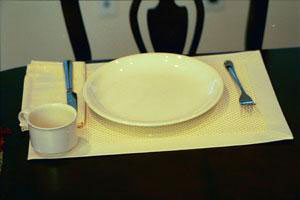Setting the Table
Eating is often viewed as an uncomfortable activity when you first begin to experience vision changes. A dinner table is a crowded place filled with silverware, plates, drinking glasses, serving dishes, and beverage-filled pitchers. But, with a few tips and practice, eating can be pleasurable again. Here are some suggestions for keeping your place at the table and making mealtimes comfortable for everyone.
- Be sure there is good light above the table to help you see as much detail as possible.
- Make sure you have control of glare with appropriate window coverings.
- Try not to use stemware since it tips over easily.
- Use contrast in your table setting—for example, set white plates on a dark tablecloth.
 | An all-white place setting is difficult to see. Here, a red napkin, blue plate, and blue mug contrast with a white placemat making the place setting easier to see. |  |
- Each time you eat, place your napkin, flatware, cup, and saucer in their location. When you first sit at a table, carefully locate these items by inconspicuously touching them. Keep your hand next to the table and slide it toward the glass, cup, bread plate, etc.
- Decide how you will set the rest of the table—main dish, side dishes, seasonings, condiments. Try arranging them in a semicircle or straight line beyond your place setting.
- When locating a beverage on the table, slide your hand across the top to find the glass and pick the glass up from the bottom, which will help keep the glass from tipping over. If the table is crowded, you may need to locate the spot for returning the glass with your other hand, then move the beverage to that hand.
- Whatever table setting you choose, be sure to do it the same way for every meal. Soon it will become second nature.